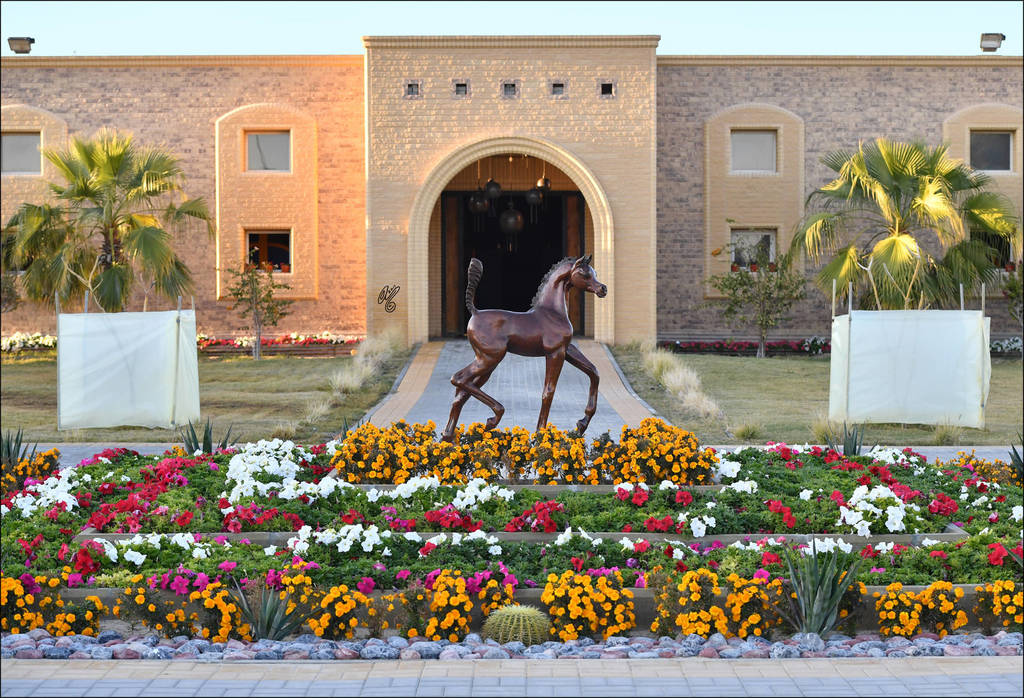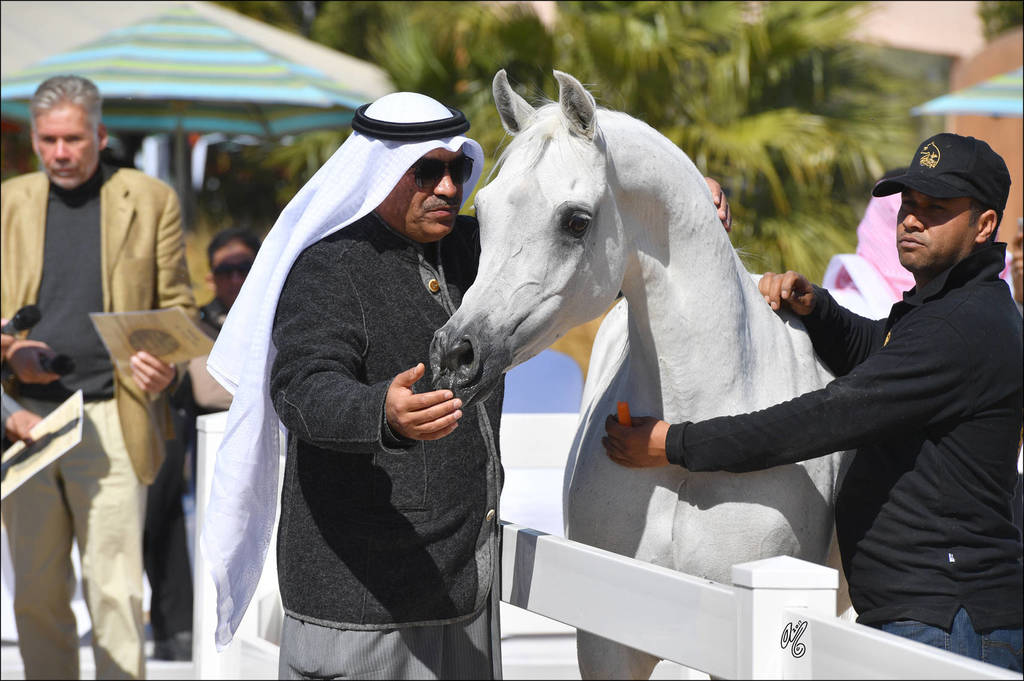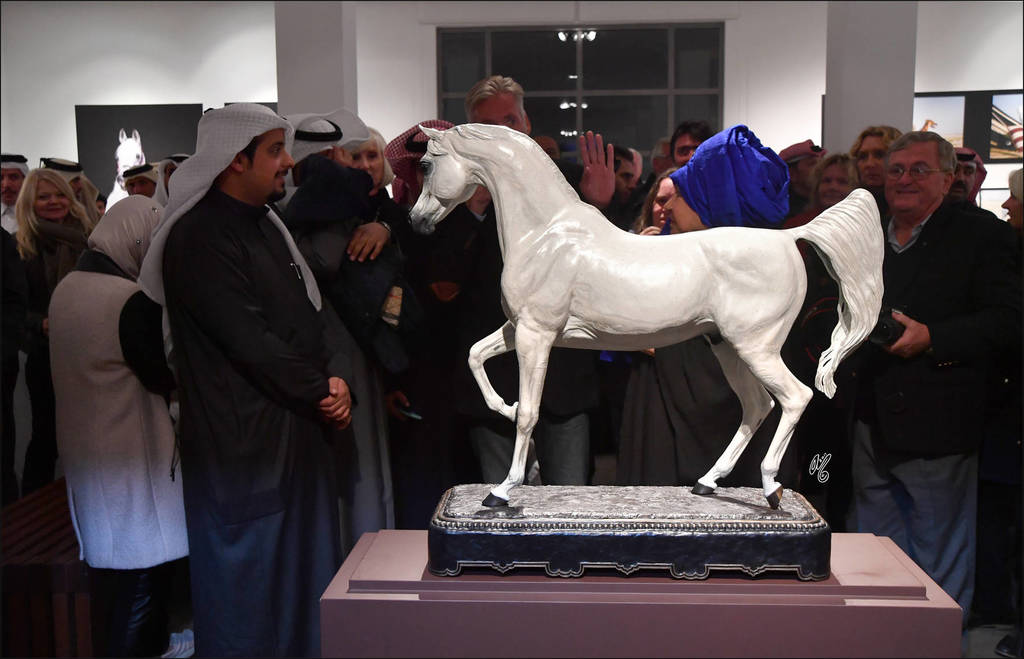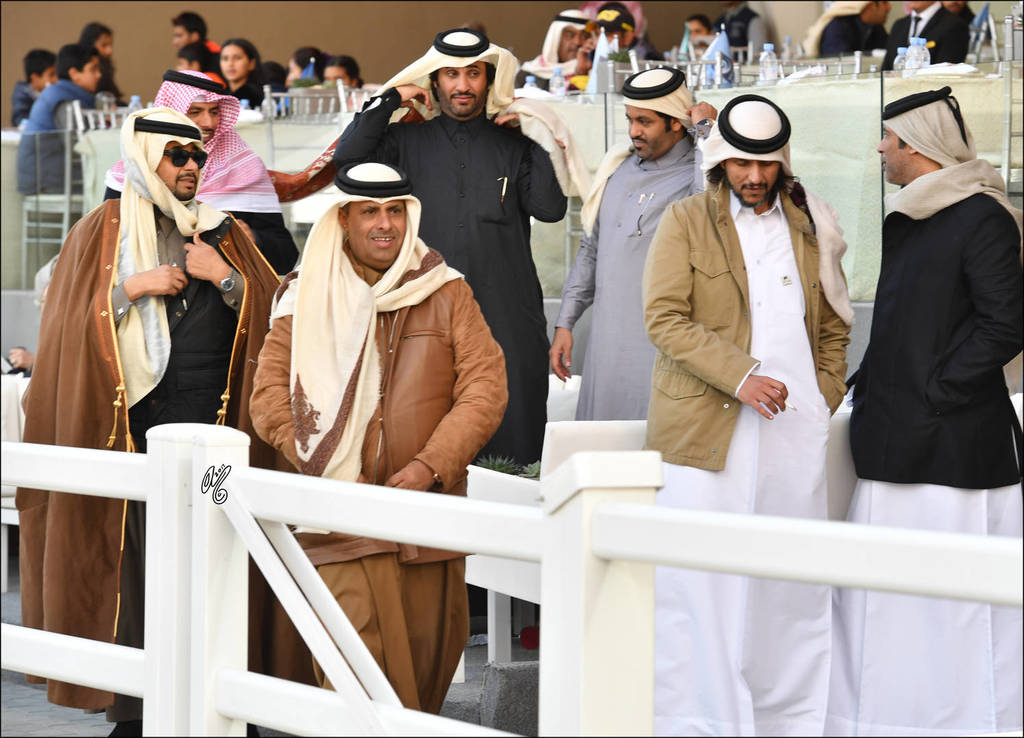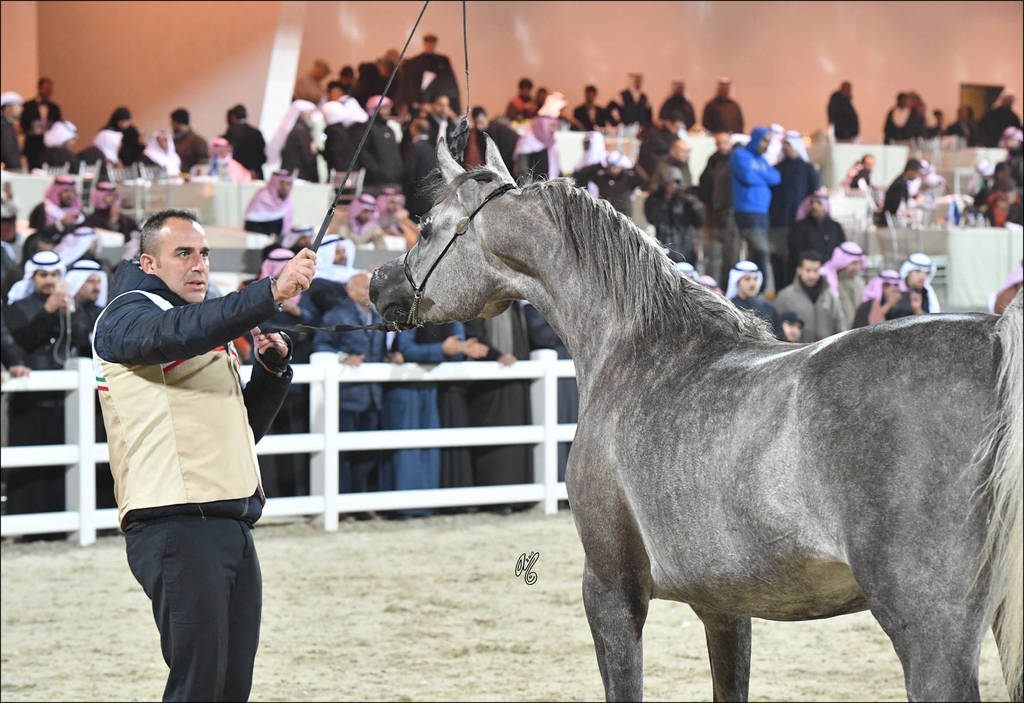2017 Kuwait International Arabian Horse Festival: All Nations Cup Straight Egyptians
The 2017 Kuwait International Arabian Horse Festival
All Nations Cup - Straight Egyptians
By Lisa Abraham
The 2017 Kuwait International Arabian Horse Festival, in its entirety, lasted from February 3-21. It began on February 3-4 with the 6th International Championship, followed by two days of Open House Stud Visits which included an exhibition of artwork by Mr. Ali Al Mimar at Bait Al Arab. Then on February 17-18, it continued with the All Nations Cup - Straight Egyptians and three more days of Open House Stud Visits with the exhibition and launch of the book Ansata Hejazi - Born to Rule. Both shows were excellently organized by and hosted at The Arabian Horse Center Bait Al Arab, the State Stud of Kuwait.
Since 2010, Kuwait has hosted National, International and Straight Egyptian events and shows with great success. Due to the diligent level of organization, generous hospitality and thoughtful breeding programs which are producing high quality horses, Kuwait’s growing presence as an International destination for Arabian horses has received great support from all over the world. The 2017 Kuwait International Arabian Horse Festival was attended by huge numbers of people who represented every major continent with involvement in Arabian horses.

Open House Stud Visits
The Open House Stud Visits were priceless opportunities enjoyed by visitors and guests of the Kuwait International Arabian Horse Festival. The second set of Open House Stud Visits took place directly after the All Nations Cup - Straight Egyptians. Thanks to excellent planning and friendly cooperation, presentations at eleven farms were enjoyed by large groups of guests who successfully caravanned from venue to venue, over a three-day span. Although these visits did follow the show, I have chosen to cover them first as I feel they give deeper insight into the Kuwaiti breeding environment and community. This will  also be beneficial in understanding the success of the show and how it was embraced. The Studs that participated in this tour included: El Adiyat Arabians, Ajmal Arabian Stud, Al Danat Stud, Aljazira Stud, Al Safinat Stud, Al Maale Stud, Mubarak Arabians, Bait Al Arab, Al Rayah & Al Sharq Stud, Al Rehab Stud and Al Salam Stud.
also be beneficial in understanding the success of the show and how it was embraced. The Studs that participated in this tour included: El Adiyat Arabians, Ajmal Arabian Stud, Al Danat Stud, Aljazira Stud, Al Safinat Stud, Al Maale Stud, Mubarak Arabians, Bait Al Arab, Al Rayah & Al Sharq Stud, Al Rehab Stud and Al Salam Stud.
First and foremost, the Stud Visits provided tremendous insight into the high level of hospitality for which Kuwaitis have become known. At each Stud, it was impressive that the owners were present to greet and engage guests. Then, from the moment of arrival, elegantly dressed servers offered chocolates, small pastries and coffee as well as other beverages to be enjoyed throughout the presentations. At the appropriate times, certain farms served incredibly elaborate meals consisting of the country’s finest foods and desserts. On Sunday (2-19) we were hosted to lunch at Ajmal Arabian Stud; on Monday (2-20), lunch was at Al Maale Stud while dinner was provided by Bait Al Arab; and on Tuesday (2-21), lunch was enjoyed at Al Rayah & Al Sharq Stud.
One of the valuable opportunities offered by the Open House Stud Visits was an intimate way to view and evaluate many of the horses who had competed. Most importantly though, due to the outstanding management of the presentations and  reference materials provided, it was the chance to learn about individual breeding programs, as well as provide a larger understanding of Kuwait’s contemporary contribution to the advancement of the Straight Egyptian Arabian horse. As many of the Studs visited were several generations deep in their programs, they were also a visual lesson in the evolution of breeding programs.
reference materials provided, it was the chance to learn about individual breeding programs, as well as provide a larger understanding of Kuwait’s contemporary contribution to the advancement of the Straight Egyptian Arabian horse. As many of the Studs visited were several generations deep in their programs, they were also a visual lesson in the evolution of breeding programs.
 From one venue to another, it was delightful to see the variations in architectural design and layout, as each farm had its own unique appearance and ambiance. However, laced throughout the presentations and the different settings, were strong consistencies that prevailed. One of the very first things I noticed was the genuine friendship the Kuwaiti breeders shared with one another. The breeders hosting presentations were
From one venue to another, it was delightful to see the variations in architectural design and layout, as each farm had its own unique appearance and ambiance. However, laced throughout the presentations and the different settings, were strong consistencies that prevailed. One of the very first things I noticed was the genuine friendship the Kuwaiti breeders shared with one another. The breeders hosting presentations were  noticeably visible at most, if not all the presentations. As it can be less common in other parts of the world, the level of sincere support the Kuwaitis enjoyed in one another was refreshing. Certainly, the entire Arabian horse industry could benefit from their valuable example in the many advantages of regional camaraderie. James Keller, a Roman Catholic priest wrote, “A candle loses nothing by lighting another candle.” To me, this statement perfectly illustrates my observations of the relationships breeders of this country seemed to share.
noticeably visible at most, if not all the presentations. As it can be less common in other parts of the world, the level of sincere support the Kuwaitis enjoyed in one another was refreshing. Certainly, the entire Arabian horse industry could benefit from their valuable example in the many advantages of regional camaraderie. James Keller, a Roman Catholic priest wrote, “A candle loses nothing by lighting another candle.” To me, this statement perfectly illustrates my observations of the relationships breeders of this country seemed to share.
It was also impressive to observe the studious nature of the Kuwaitis who also attended the Stud Visits. They would group together with the presentation reference materials and engage in serious discussions; many were digitally recording horses while also taking notes; and finally, photographers were working hard to create unique perspectives. Bait Al Arab has been a leader in education regarding the various aspects and opportunities involved with Arabian horses. Every year, free of charge, the State Stud offers seminars and courses related to horse health, stud management, grooming & training, horsemanship, as well as a National Judges Course, which is done in cooperation with European Conference of Arabian Horse Organizations (ECAHO). Furthermore, Bait Al Arab encourages photographers with contests offering large prizes. It seems certain that this outstanding leadership and support have provided multiple paths for the people of Kuwait to successfully enjoy relationships with Arabian horses.

The Launch of the new book: Ansata Hejazi - Born To Rule
The Bait Al Arab visit, which took place on the night of February 20th, combined its presentation of horses with the launching of the book, Ansata Hejazi - Born to Rule, by Judith Forbis. The evening was both magical and unforgettable. The festivities began with a very special presentation celebrating the life of Ansata Hejazi through his contribution to the Arabian Horse Center. It is worth recognizing that the arena used for this presentation, like everything else associated with Bait Al Arab, was well designed from the perspectives of function, comfort and beauty - all three were accomplished and nothing was  compromised. There were also subtle details to the lighting which added even more warmth and elegance to the occasion.
compromised. There were also subtle details to the lighting which added even more warmth and elegance to the occasion.
The presentation opened with a stallion the Arabian Horse Center acquired in 2014, the Ansata Hejazi son, Ansata Sheikh Halim (x Ansata Samiha), bred by Chase Arabians LLC and Ansata Arabian Stud. Then both in groups and one-by-one, pearls of the program were presented until the breath-taking finale, one that everyone who was fortunate enough to attend, will never forget: five beautiful Ansata Hejazi daughters were presented together at liberty…I do not exaggerate when I write, for that moment in time, it felt as if the entire world stopped turning to honor the heritage of these mares and the depth of their value to the county of Kuwait.
On May 8, 1992 Ansata Hejazi was born at Ansata Arabian Stud, owned by Donald and Judith Forbis, in Mena, Arkansas (USA). He was by their chief sire, Ansata Halim Shah and out of Ansata Sudarra, who traced back to Ansata Bint Bukra, one of the Ansata Foundation horses. In 1999, even though he was not for sale, Mr. Mohammed J. Al Marzouq of Kuwait, purchased Ansata Hejazi, along with the mares: Ansata Nefertiti (a full sister to Ansata Hejazi), Ansata Samari (Ansata Hejazi x Ansata Samari) and Ansata Shalimar (Prince Fa Moniet x Ansata Samantha). Although Ansata Hejazi’s career as an important sire began in the United States, through the intelligence, generosity and foresight - all in equal parts - of Mr. Al Marzouq, not only did his significance come to be appreciated all over the world, but also and more importantly, he influenced a single nation as no other stallion has before, and very possibly, ever will again.
Lisa Abraham: What was your attraction to Ansata Hejazi?
Mr. Al Marzouq: I bought Ansata Hejazi when he was 6 years of age. I was very impressed with his classic type, charisma and conformation and, most importantly, that these traits were just as visible in his foals.
 Lisa Abraham: His breeder, Judith Forbis, has stated that Ansata Hejazi was "…the right horse, at the right time." From the perspective of the rebuilding of Kuwait following the Iraqi invasions, can you elaborate on this statement? Please also include the qualities that you felt he possessed as a sire and/or unique circumstances which allowed him such influence.
Lisa Abraham: His breeder, Judith Forbis, has stated that Ansata Hejazi was "…the right horse, at the right time." From the perspective of the rebuilding of Kuwait following the Iraqi invasions, can you elaborate on this statement? Please also include the qualities that you felt he possessed as a sire and/or unique circumstances which allowed him such influence.
Mr. Al Marzouq: After the invasion, there were only 26 Arabian registered horses left in Kuwait and there was no real stallion power. Hence, when I was considering Ansata Hejazi I was thinking first of my country’s interest before my own breeding purposes. For that reason, he was open to public use at no charge. Due to his ability to produce both stallions and mares of equal eminence, he provided a strong foundation for Kuwaiti breeders and was indispensable to the establishment of the straight Egyptian program in Kuwait.
Lisa Abraham: Ansata Hejazi: Born to Rule is an incredible tribute to a stallion who has known unique notoriety. Can you share some of your own feelings?
Mr. Al Marzouq: For as long as I can remember, it had been my ambition to not only be a proud owner of Arabian horses and to participate in the development and perfection of their breeding, but also to make a contribution to the establishment of their blood lines, in the land of their forefathers. With Ansata Hejazi, my breeding goals have been achieved and, within a very short period, Kuwait has become a leader among the best straight Egyptians breeding programs available.
The idea of this book was initiated by Judith, to whom I gave my full support. For me this book is honors both Ansata Hejazi and his breeders. I was fortunate to get Don and Judith’s support as Ansata Hejazi was a wonderful stallion who was reason for my country's unique position in the breeding of straight Egyptian horses. On the night of the book release, it was very emotional for me to see how much this stallion was loved by so many people. For me Ansata Hejazi will always be remembered as the stallion who helped me achieve my dreams and brought joy to my life.
After the presentation of the Bait Al Arab horses, all guests adjourned to a gallery thoroughly staged to accommodate the release of this historic manuscript, celebrating the life of Ansata Hejazi and his contribution to Kuwait. Throughout the gallery were beautiful displays and diagrams from the book and gorgeous artistic portrayals of this beloved stallion. The energy of the occasion was amazingly high as the room was packed full of people eager to participate in this special moment--it was easy to observe that history was being made and everyone wanted to celebrate in it. Its author Judith Forbis was present for the occasion and was accompanied by Mr. Al Marzouq and Sheikh Hamad bin Ali Al Thani, of Al Shaqab Stud (QAT). When all the photos and videos had been taken, interviews done, speeches made, as a group, we walked a path through the cool, clear night air to a series of tents where we shared a traditional meal, accompanied by the music of the region. It was a story book ending to a perfect evening.
 Judith Forbis: After more than two years of developing this book in cooperation with managing editor Cynthia Culbertson and other important contributors, it was a supreme pleasure for me to assist in hosting Hejazi's many international fans who attended the launch of this long-anticipated publication. Although the entire evening was filled with excitement and charged with energy, the ribbon cutting ceremony, prior to entering the
Judith Forbis: After more than two years of developing this book in cooperation with managing editor Cynthia Culbertson and other important contributors, it was a supreme pleasure for me to assist in hosting Hejazi's many international fans who attended the launch of this long-anticipated publication. Although the entire evening was filled with excitement and charged with energy, the ribbon cutting ceremony, prior to entering the  exhibition hall, was very emotional for me. I was unaware of that part of the agenda, so it came as a complete surprise. It was an unforgettable opportunity to share that experience with numerous long-time friends and I will always cherish that memory.
exhibition hall, was very emotional for me. I was unaware of that part of the agenda, so it came as a complete surprise. It was an unforgettable opportunity to share that experience with numerous long-time friends and I will always cherish that memory.
I am especially grateful to Bait Al Arab's team who worked so diligently to provide a perfect presentation of Hejazi-influenced stallions, mares and foals as a tribute to this noble stallion. Turning loose the five Hejazi daughters as an artful and breathtaking conclusion to the State Stud's presentation deeply touched my heart and brought back memories of Hejazi's birth. From the time he was born, he appeared to be a very special gift from above. Endowed with a heavenly white star on his forehead and with silver hairs surrounding his inquisitive large eyes, we knew he would one day become white--a color symbolic of victory and success. However, at that time, we could not foresee that he would eventually become 'a king' and live up to the Arab saying about the white horse, ‘This is the mount of kings, because it brings good fortune and luck, and with it you are able to obtain what is necessary.' He was smart, kind and gentle yet aristocratic in demeanor. His classic beauty, overall balance and bold long-reaching trot impressed all who saw him. As he grew into a magnificent and charismatic stallion, winning in the show ring and siring outstanding foals, he indeed proved to be a special gift.
I remember so well the day when Mohammed came to Ansata, in 1999. After seeing Hejazi at the Egyptian Event in Lexington, he was absolutely determined to buy him. Although Don and I were adamant about his importance to our own breeding program, Mohammed convinced us that Hejazi could serve to inspire and elevate the Arabian horse breeding programs in Kuwait after its devastation from the Gulf War. So, after much consideration, we agreed to let Hejazi return to the land of his ancestors. Although we had great confidence in Hejazi’s future as a sire in that country, we could have never guessed the unbelievable impact this stallion would have--and still does have--through succeeding generations carrying his blood. As his breeder, even I am overwhelmed by his accomplishments. To me, he was a real live horse hero--not just a fictional one conceived in an author's mind.
For more than two decades Ansata bloodlines have been a major influence in Kuwait’s well-planned breeding programs. It has been a life-fulfilling experience for me to have been involved in the dramatic restoration of the country's Arabian horse heritage. In a very short period of time, Kuwait has firmly established itself as a prime destination in the Arabian horse world. Considering Hejazi's immeasurable contribution to this nation, it is no wonder its patriotic breeders fondly called him the 'King of Kuwait'.

All Nations Cup - Straight Egyptians
The All Nations Cup - Straight Egyptians took place on February 17-18, 2017, in Kuwait, at the Arabian Horse Center - Bait Al Arab. Under the patronage of H.H. Sheikh Sabah Al Ahmed Al Jaber Al Sabah and in cooperation with the All Nations Cup Committee represented by its Chairman Dr. Hans J. Nagel, the All Nations Cup - Straight Egyptians celebrated its second year as a show with growing international importance. Evidence of its bright future as a show was the quality and volume of its attendance, representing both regional and international destinations. As for the competition, although breeding programs from all over the world were represented, the participating nations included: The Kingdom of Saudi Arabia, Qatar, Egypt, Jordan and Kuwait.
In its design, the VIP section was thoughtfully planned. From a viewing perspective, there was not a bad seat as all vantages points were equal. But it was also comfortable, easy to navigate and, due to the position of seating, facilitated socializing and crowd spirit - which was high. Both the VIP and surrounding viewing areas were filled with guests and spectators, despite difficult weather conditions. However, thanks to intelligent foresight and planning, the show organizers were prepared for the unusually cold temperatures and precipitation with appropriate accommodations. This elevated hospitality was appreciated by those in attendance and certainly added to the charm of the event.



Championships
The classes were judged using the 20-Point System in which half points could be utilized. The categories for scoring included: Type, Head, Neck, Body & Topline, Legs and Movement. As an indicator of its importance, the score for TYPE was multiplied by two. In the qualifying classes, ties were resolved by giving the higher placement to the horse with the most points for TYPE. If that did not resolve the tie, the score for MOVEMENT decided. Finally, if that failed to resolve the tie, one judge who was chosen by ballot named his/her preference. In the Championships, a tie was resolved by giving the higher placement to the horse with the highest Qualifying Class score. If that did not resolve the tie, then the procedure for ties in the qualifying classes was applied. The Championships were judged comparatively according to the so called ‘open championship method’ of ECAHO. Only the class winners and second place horses were qualified to compete in the Championships.
 The panel of Judges: Doug Dahmen (USA), Wladyslaw Guziuk (POL), Mark Ismer (DEU), Christian Moschini (ITA), Peter Pond (AUS) Anna Stojanowska (POL), Marianne Tengstedt (DNK) and Cristina Valdes (ESP).
The panel of Judges: Doug Dahmen (USA), Wladyslaw Guziuk (POL), Mark Ismer (DEU), Christian Moschini (ITA), Peter Pond (AUS) Anna Stojanowska (POL), Marianne Tengstedt (DNK) and Cristina Valdes (ESP).
The Yearling Filly Gold Champion was Zainah Al Nawasi (Asfoor Al Waab X Zahyah Al Nawasi), who was bred by Al Nawasi Stud (KWT) and is owned by Allam Ali Alkandari (KWT). With a class score of 92.43, Zainah Al Nawasi was the highest scoring yearling of the show. Additionally, in her class she was awarded three 20’s: one for TYPE and two for HEAD. The Silver was awarded to Rayah Aldanat (Al Adeed Al Shaqab X Ajmal Sharifa), who was bred and is owned by Aldanat Stud (KWT); while the Bronze went to Marbia Al Salam (Alsheikh Obaid Almoghazy X Lamia Adel), who was bred and is owned by Mohammed Hamad Al Rukhayes (KWT).
The Yearling Colt Gold Champion was Jarrah Al Wafi (Dahes Al Rayyan X Shaikha Al Wafy). Jarrah Al Wafi was bred by Sheikh Abdullah Ali Al Sabah (KWT) and is owned by Sheikh Mohammad Ali Al Sabah (KWT). The Silver was earned by Muhallab Al Shajar (Taleb Al Shaqab X Alya Al Shajer), who was bred by Alshajer Arabians (KWT) and is owned by Shiekh Ali Nasser Al Sabah (KWT). Interestingly, Muhallab Al Shajar’s placement was an excellent example of how a performance can be can be improved upon in the Championship. In his qualifying class, he scored a 91.07 which was the lowest of all competing colts in this Championship. Finally, the Bronze was earned by Aabs Al Khashab (Motair Al Baidaa X Khadijah by Khalila), who was bred by and is owned by Mubarak Hamdan Al Khashab (KWT).

The Junior Female Championship was deeply competitive. In their Fillies 3 Years Qualifying Class, Mashhoora Al Shaqab (Ansata Nile Echo X Lian Al Shaqab) and Hikayet Hob AA (Al Ayal AA X Hamdiyah AA) tied with a score of 92.64. However, they were also tied with a TYPE average score of 19.50. With a MOVEMENT score of 18.6, .40 points ahead, Mashoora Al Shaqab became the class winner. However, on Championship day, it was Hikayet Hob AA, a 2014 filly who was bred by Ariela Arabians (ISR) and is owned by Ahmad Abdulaziz Albabtain (KWT), who became the Gold Champion in a near unanimous win. While Mashhoora Al Shaqab, a 2014 filly who was bred and is owned by Al Shaqab Member Qatar Foundation (QAT), earned the Silver. The Bronze went to Alsafa Al Jazira (Waseem ElKuwait X Jalila Al Jazira), a 2015 filly who was bred and is owned by Aljazira Stud (KWT). Interestingly, Alsafa Al Jazira, the youngest of the three medal winners also showed an improved placement in the Championship.
The Junior Male Gold Champion was D Monaf (Royal Colours X D A Aniqah), a 2014 colt who was bred by Dubai Arabian Horse Stud (UAE) and is owned by Ali Matar Al Wawan (KWT). With a qualifying class score of 93.21, D Monaf received the highest score of all junior and yearling competitors, and the third highest of the show. The Silver was awarded to Ezz Aldanat (Shamekh Al Danat X Shalwa), a 2014 colt who was bred and is owned by Aldanat Stud (KWT). In his qualifying class in which he placed second to D Monaf, Ezz Aldanat was awarded two 20’s: one for TYPE and one for HEAD. The Bronze went to the youngest of the three medal winners, Osama Al Daar (Dhahab Aldanat X Rizgat Al Bawadi), a 2015 colt who was bred and is owned by Al Daar Stud (KWT).
The Senior Females are always a show highlight - and the quality of the competition was high. For example, as a group, the Senior Female Medal winners, represented the highest score average of all Championships. Ultimately the Gold was awarded to Menouah Al Rayyan (Fares Al Rayyan X Bint Messoudah M HP), a 2012 mare who was bred and is owned by Al Rayyan Farm (QAT). In her qualifying class, Menouah Al Rayyan earned four 20’s: one for TYPE and three for HEAD. The Silver was earned by Maysuna Guasimo (Al Adeed Al Shaqab X Najib Guasimo), a 2009 mare who was bred by Frederico Fogarin (ITA) and is owned by Aldanat Stud & Al Fala Stud (KWT). Impressively, with a qualifying class score of 93.57, Maysuna Guasimo was the highest scoring horse of the show. Finally, the Bronze went to Tibrah Al Shaqab (Farhoud Al Shaqab X Twom Hiddiyya), a 2012 mare who was bred by and is owned by Al Shaqab Member Qatar Foundation. To further illustrate the  depth of quality in this Championship, in her qualifying class, Tibrah Al Shaqab was awarded the same score as the Junior Female Gold and Silver Champions.
depth of quality in this Championship, in her qualifying class, Tibrah Al Shaqab was awarded the same score as the Junior Female Gold and Silver Champions.
From a qualifying class perspective, the Senior Male Medal winners represented the second highest score average among Championships. Also, this was the only Championship in which the winner was chosen unanimously. The Gold was earned by Adham Sakr (Imperial Madori X Ameera Saqr), a 2007 stallion who was bred by Omar Sakr (EGY) and is owned by Sheikh Mohammad Ali Al Sabah. With a qualifying class score of 93.5, Adham Sakr earned the second highest score of the show. In addition, he earned five 20’s: two for TYPE and three for HEAD. The Silver went to Haizoom Al Asil (Kamal Ibn Adeed X Ansata Omniya), a 2012 stallion who was bred by Anne E. Wright or F. Grande Trust (USA) and is owned by Ayman Al Qattan (KWT); while the Bronze was earned by Amir El Hejra (Nader Al Jamal X Kenya PG), a 2010 stallion who was bred by Al Daar Stud (ITA) and is owned by Al Daar Stud (KWT).
Awards
Bait Al Arab has been very successful in encouraging a breeding environment which is flourishing through the county. Of the 118 horses who competed in this International competition, 97 of them were bred and born in Kuwait. One of the very special features of the Kuwait shows is the recognition given to horses which were “home bred.” In addition to the class and medal winners, three special awards were given: Best SE Arabian Female bred and born in Kuwait, Best SE Arabian Male bred and  born in Kuwait and the Most successful Kuwait SE Arabian Horse Breeder Award. The Best Female and Male awards were given to those horses with the highest class scores. The Most successful Breeders Award was determined by total points earned by class placement, in which only the five best results per Kuwaiti horse breeder were counted. With a Class score of 92.93, Shalwa (Sinan Al Rayyan X Al Galyla), who was bred by Essam Al Roumi and is owned by Aldanat Stud, was recognized as the Best SE Arabian Female
born in Kuwait and the Most successful Kuwait SE Arabian Horse Breeder Award. The Best Female and Male awards were given to those horses with the highest class scores. The Most successful Breeders Award was determined by total points earned by class placement, in which only the five best results per Kuwaiti horse breeder were counted. With a Class score of 92.93, Shalwa (Sinan Al Rayyan X Al Galyla), who was bred by Essam Al Roumi and is owned by Aldanat Stud, was recognized as the Best SE Arabian Female  bred and born in Kuwait. With a Class score of 92.5, M Anan (Ansata Al Murtajiz x Aroub Asayel) was recognized as the Best SE Arabian Male bred and born in Kuwait. M Anan, who was bred by Mubarak Arabians and is owned by Mohammed Al Mubaraki, was the Stallions 4-6 Class winner. Finally, the Most successful Kuwait SE Arabian Horse Breeder Award went to Mohammed Al Mubaraki, of Al Mubarak Arabians.
bred and born in Kuwait. With a Class score of 92.5, M Anan (Ansata Al Murtajiz x Aroub Asayel) was recognized as the Best SE Arabian Male bred and born in Kuwait. M Anan, who was bred by Mubarak Arabians and is owned by Mohammed Al Mubaraki, was the Stallions 4-6 Class winner. Finally, the Most successful Kuwait SE Arabian Horse Breeder Award went to Mohammed Al Mubaraki, of Al Mubarak Arabians.
The All Nations Cup Trophy for Straight Egyptians is the grand trophy which was awarded to the Nation whose entries score the highest number of points per a determined scale in which both Class and Championships scores are considered. Horses compete for the Nation where the owner has his/her citizenship at the closing date of entry (2016-12-29). In the case of joint ownership, only one nation was considered. The All Nations Cup – Straight Egyptian Breeders Trophy, which is also referred to the Sheikha Salwa Al Sabah Memorial Trophy, is based on the same scale as the All Nations Cup – Straight Egyptians Trophy, recognized the country where the breeder has his/her citizenship at the time of birth of the respected horse. The country of Kuwait was the recipient for both prestigious awards.

For a FULL SIZED gallery of images:
~
For information on Bait Al Arab:
http://www.baitalarab-kw.com/#page/0
~
For information on ECAHO (European Conference of Arab Horse Organizations):
~
Lisa Abraham is an International Journalist and Photographer from the United States. Although she does free-lance for various media, her primary dedication is to Arabhorse.com as a Premier Contributor and Representative. She is also a breeder of Straight Egyptian Arabians.




